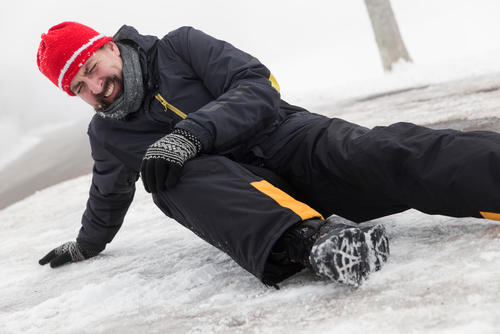By properly maintaining sidewalks, parking lots, curbs and other outdoor pedestrian spaces, winter’s slips, trips and falls can be reduced or eliminated.
Slips, trips and falls in outdoor environments can be caused by rain, sleet, ice and snow and particulate soil that cause surfaces to become slippery or produce poor traction.
While we cannot control environmental conditions that increase slipperiness of outdoor walkway surfaces, we can certainly reduce the likelihood of falls through improved design of exterior sidewalks, curbs, parking areas, improved lighting and improved maintenance to increase awareness and eliminate hazards.
Reducing Trip Hazards
A trip occurs when the foot strikes a near-ground obstacle that abruptly arrests the movement of the foot when the body’s center of gravity is in motion. This causes the center of gravity to rapidly move out of the area of the body’s support base (the planted foot), resulting in a fall.
A trip most often results in the person falling forward, while a slip most often results in the person falling backward.
Most state, local and federal codes and standards describe changes in level of 1/4 inch or higher in the course of travel as a trip hazard. These obstacles should be eliminated through facility design or maintenance, if at all possible. However, if elimination is not possible, other options include:
- For changes in level of 1/4 inch to 1/2 inch (6 mm to 13 mm), bevel the edge with a slope no greater than 1:2. The slope is the angle of incline, usually given as a ratio of the rise (or vertical height) to the run (or horizontal length). The larger the run, the more gentle the incline angle.
- For level changes greater than 1/2 inch (13 mm), install a ramp with a maximum slope of 1:12.
- A third, but less desirable option, is to make the hazard noticeable through appropriate detectable warnings.
Preventing Slips and Falls
A business owner may not be responsible for injuries resulting from a fall on a public sidewalk located outside his or her property.
However, some courts may impose liability for injuries on a sidewalk used exclusively by customers coming to and from the business. (Consult with your legal counsel if you have questions on liability.)
De-Icing Surfaces
Once physical hazards such as uneven pavement, poor lighting and unmarked ramps are remedied, then attention can be turned to the weather-related conditions of walking surfaces.
Slips and falls from snow, rain and ice are common in northern climates. Falls can be caused by inadvertent accumulation of ice and snow due to misapplication of deicing measures. Misapplication can be caused by selecting less-efficient de-icing chemical(s) and friction additives (sand), and inadequately managing application schedules.
Effective ice removal often occurs during the day with full sun. But full sun will melt adjacent snow or ice, placing water on the de-iced walking surface. This will dilute the solution and tend to refreeze at night. With dropping temperatures, ice can re-form with falls occurring first thing in the morning.
The initial step in de-icing is choosing a de-icing agent. When selecting ice-melting chemicals, here are some things to remember:
- Rock salt (sodium chloride) is the least expensive but is somewhat corrosive and can damage concrete, interior surfaces and vegetation. It may need a wetting agent when used at low temperatures.
- Calcium chloride and magnesium chloride are more effective than rock salt, and most effective at lower temperatures. Magnesium chloride is somewhat less corrosive than calcium chloride, which is about as corrosive as rock salt.
- Calcium magnesium acetate is the most environmentally friendly but is more expensive and is least effective at lower temperatures.

